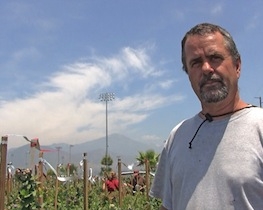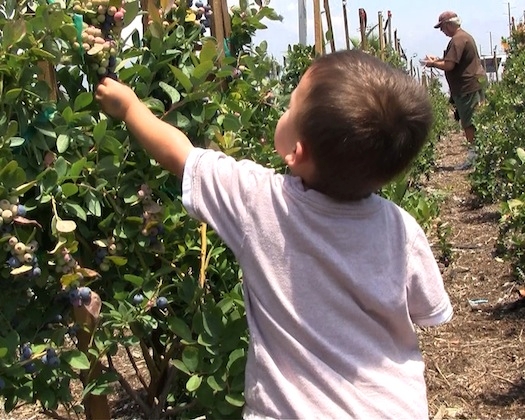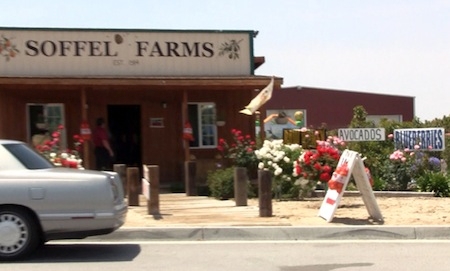For foodies, being choosier is getting easier and fun
This season, for Southern California pick-your-own foodies, blueberries are among the latest and fastest growing offerings, thanks to the tenacity of small-scale farmers and the know-how provided by UC Agriculture and Natural Resources experts.
Although U-pick produce operations have been around for many years, farmers who let you hand-pick your blueberries was unheard of in this part of the state until recently.
We may have to thank UC Cooperative Extension farm advisor Manuel Jiménez, who's work on cultivars that he planted in 1997 at the UC Kearney Agricultural Research and Extension Center in Parlier has resulted in about 30 million pounds harvested in about 6,000 acres this year in California, mostly in the San Joaquín Valley.
A few days ago, my wife, Sylvia, and I decided to try our hand at picking our own berries at Soffel Farms in Redlands. It's one of the few local urban farms, or rather farms that became urban in the Inland Empire Area, which is San Bernardino and Riverside counties.
For the second year in a row, Soffel Farms is letting customers harvest as much as they want of its blueberries. This year, Ron Soffel is seeing people who drive more than a hundred miles to do just that.
"They don't see these around here, the closest are when you go up north to the San Joaquín Valley," he said of the blueberries as a new local crop.
By word of mouth, and of quite a few bloggers, locals and not so locals are showing up to pick the micro-nutrient rich blueberries, which many foodies see as magic pills in the fight against some types of cancer and obesity-related diseases like diabetes.
Of course, an incredible flavor helps too. For sure, pickers leave with a better understanding of what it's like to grow and harvest the foods that keep us healthy.
"Once they come up, and experience it, they come back," said Soffel.
Soffel Farms operates very much like other U-pick small-scale farms that are benefiting from agritourism, which UC small farm program has helped to develop to assist local growers. You check in, they give you a little basket and a couple of pointers:
- Walk carefully along the rows of bushes so do not damage the plants.
- Get only the ones that are purple; place the basket under the berries and gently roll your thumb over a berry to make it fall in the basket. (They do, just as if they were waiting for you!)
After you've picked enough, you go back and your berries are packed in 12 oz. plastic containers for which you pay $5 each.
I confess, my wife and I didn't wait until we got home to make sure we had gotten the most delicious blueberries we'd ever tasted! Once you taste a handpicked blueberry, it's hard not to eat some of the ones that should go into the basket.
I felt less guilty after seeing Soffel do the same as we spoke. Other visitors did it too, including a five-year-old who was accompanied by his grandparents, from San Diego. None of his blueberries went to a basket, but straight to his tummy.
"Purple!" he told me every time he put one in his mouth as we went along picking berries. He was the proverbial kid in a candy store. Thank goodness there was lots of that Mother Nature's candy.
As a consumer, I'm thankful that we have our own Manuel Jiménez, who tirelessly proved that blueberries could and should be added to the California cornucopia. And also for the determination of small growers like Soffel in keeping the agriculture tradition alive.
Although many farmers in California are now finding that blueberries are relatively easy to grow, Soffel says it's labor intensive. But it's helping him to keep his family tradition. Like many small-scale farmers, Soffel depends on direct sales. Adding blueberries to his pick-your-own operation, which includes a few acres of orange trees and avocados, is so far proving to be a good source of income, he said.
Soffel is typical of the decreasing number of local growers. They are constantly threatened by urbanization and its accompanying regulations. Soffel is a fifth generation farmer whose ancestors came from Oregon by wagon. The Stoffel Farms sign reads, "Established in 1914." Soffel says his family was among the pioneers that made the Redlands area famous for its oranges.
Most orange groves are gone and have been replaced by housing and commercial buildings; but Soffel and his family refuse to cut their roots to farming.
"I'll be a farmer forever," he told me.
I hope so. I'm waiting for word about his avocados being ready for picking.
(Photos: Alberto Hauffen)






Posted by Joseph sailors on June 22, 2012 at 12:47 PM